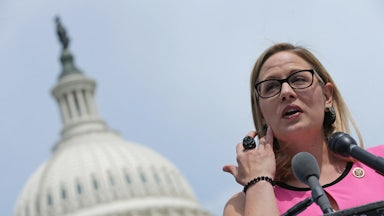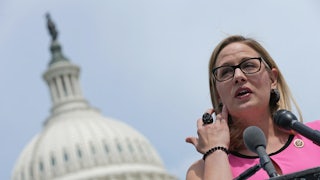In the iconic two-part Star Trek: Voyager episode “Year of Hell,” the fearless crew of the Voyager faces a time ship that is able to erase certain events from history, resulting in an alternate timeline where a foe that was easily dismissed is suddenly an unstoppable force.
“This is turning into the week of hell,” Capt. Kathryn Janeway quips toward the beginning of the first episode. But the pain of the week extends, and the crew of the Voyager fights bruising battles for a whole year. Eventually, the crew manages to reset the timeline, so that the titular year of hell never happens. But in the final scene, we see the scientist who created the time ship working on his calculations to alter time—indicating that the year of hell could happen yet again, even though the timeline was reset.
Congress began its very own week of hell on Monday. The House has opened debate on the bipartisan infrastructure bill crafted in the Senate, with a final vote on the bill scheduled for Thursday. A massive bill containing a mishmash of Democratic priorities must also be ready for a vote by Thursday, otherwise progressives have sworn to tank the bipartisan bill. Also, unless Congress passes a continuing resolution, or C.R., by Friday, the government will shut down, so that’s neat.
Congressional Democrats tied a C.R. funding the government through December 3 to funding for emergency disaster relief and resettling Afghan refugees, as well as a debt ceiling suspension. But Senate Republicans refused to support any legislation suspending the debt ceiling, so the C.R. failed to advance on the Senate floor on Monday. (Democrats have only 50 seats; they need 60 votes to advance legislation, yadda yadda.)
“Let me be clear: what the Republicans in the Senate did today is not normal,” Senate Majority Leader Chuck Schumer said after the vote, warning of the impending “Republican default” and slamming “one of the most reckless, one of the most irresponsible votes I have seen [taking] place in the Senate.” The vote failed 48–50, with Schumer voting against the bill so that he has the option to bring it back to the floor at a later time. Schumer pledged in his remarks that the Senate will take “further action” to avoid a shutdown or default, although he did not offer specifics about what that further action will entail.
Democrats must now find a way to pass a bill funding the government by Friday and to raise the debt ceiling on their own before the X Date—the impending cooler-than-it-sounds date on which the country will default on its debts, expected to be sometime between mid-October and the beginning of November.
While this is not normal, because a functioning legislature should not flirt with economic catastrophe on the reg, it’s not unusual. For the past 10 years, the fight over raising the debt limit has been a perennial opportunity for political brinkmanship, allowing one party to threaten default to extract concessions from the other.
Raising or suspending the debt ceiling acts as a reset of the timeline. (Raising the debt ceiling puts an exact dollar amount on how much the country can borrow, whereas suspending pauses the limit to a certain date, at which point the limit goes back into effect.) With a suspension, the crisis is averted; things go back to normal—until two or so years later, when we go through it all over again.
In 2019, Congress suspended the debt ceiling on a bipartisan basis until the end of July this year. This time around, Republicans aren’t even trying to gain anything with their opposition to suspending the debt limit—they just don’t want to help suspend it, and they (not inaccurately) say that they don’t have to. Democrats have control of both houses of Congress and the White House, and they can raise the debt ceiling by themselves.
Democratic objections—raising the debt ceiling should be bipartisan; Republicans are just as responsible for the current debt, much of which was accumulated under a GOP president—have fallen on deaf ears. They gambled that Republicans would fold when faced with economic catastrophe, and that bet failed. So now congressional Democrats can choose to continue ratcheting up the pressure on Republicans or do something they could have done much earlier: include a debt ceiling hike in the budget reconciliation process.
In remarks on the Senate floor, ahead of the vote, Senate Minority Leader Mitch McConnell reaffirmed that Republicans were ready to pass a “clean” C.R., sans debt ceiling hike, and believe Democrats “have all the time and all the tools to do what they have to do” to raise the limit—indicating that GOP senators are unlikely to back down anytime soon.
“The next 24 hours will be key, as Democrats decide what option they want to use,” said Zach Moller, a former staffer on the Senate Budget Committee and the director of the economic program at Third Way, a center-left think tank. They could inch closer to the brink of shutdown and, later, default and dare Republicans to say no again. (In one scenario, Republicans could just agree not to filibuster the bill, meaning that the C.R. could pass with a simple majority.) But if this strategy doesn’t succeed, Democrats can start working on plan B.
You can argue that Democrats should have done this sooner. You can argue that Republicans should have voted to suspend the debt limit. Neither matters, because this is the situation we have.
Welcome to hell. Now, how can we escape?
Democrats, in particular House Budget Committee Chair John Yarmuth, have argued that there isn’t sufficient time to use the reconciliation process to raise the debt ceiling. This isn’t strictly true—if they really hustle, they can perhaps complete the process in as little as 10 days.
There’s one hitch: We don’t know when the X Date is, so every day brings us closer to potential default, and the markets will get skittish as the date nears. Even just getting close to a default could still be very bad for the economy. “The uncertainty on the time it is going to take to do it, and the uncertainty on the default date, has greatly increased the risk,” Moller said.
Our first stop on the world’s saddest procedural choo-choo train is revising the budget resolution for fiscal year 2022 to include an instruction to raise the debt limit by some dollar amount.
Democrats are using the budget reconciliation process to pass their big bill, including a laundry list of priorities. This requires first passing a budget resolution to lay out instructions for committees to craft the reconciliation bill, which House and Senate Democrats did in August. As we know, they did not include a debt ceiling hike in their resolution.
Still with me? Here’s where it gets annoyingly technical.
The Senate parliamentarian, the top expert on Senate procedural matters, who acts as a referee advising what the chamber can and cannot do under the rules, issued an opinion in June setting ground rules for revising a previously adopted budget, as authorized by Section 304 of the Congressional Budget Act passed in 1974. (I told you it got annoyingly technical.)
So here’s what the Senate can do: Revise the existing budget resolution for fiscal year 2022, which was used to set instructions to craft the reconciliation bill. The revised resolution can ask the Senate Finance Committee and the House Ways and Means Committee to raise the debt limit to some dollar amount. (The parliamentarian would likely not accept a suspension of the debt ceiling, meaning that they will have to raise it.)
If you make it through the rest of this section, I will reward you with a fun fact.
The initial fiscal year 2022 budget resolution, which passed in August, did not have to go through a Budget Committee markup, but was auto-discharged. The Budget Act requires that the Budget Committee report a budget resolution by April 1. If the committee is late to report a budget resolution, it is automatically discharged from consideration by the committee, meaning that it can just go straight to the Senate floor.
Parliamentarian Elizabeth MacDonough said in her June opinion that a budget resolution revised under Section 304 would not be eligible for an auto-discharge. This means that the revised resolution will have to be considered by the Budget Committee before it can make it to the Senate floor.
If they want to, Republicans can gum up the works by refusing to attend the markup and denying the committee a quorum. But assuming they do attend, the committee will likely deadlock, as every committee has an equal party split. Under current Senate rules, the bill would still be discharged to the floor if there is a tie vote in the committee, but the discharge procedure is complicated (shocker) and eats up valuable time.
Once the Senate takes up the budget resolution, there will be 15 hours of debate equally divided, followed by a “vote-a-rama,” a marathon voting session on a series of amendments, most of which are brought by the minority party and intended to be politically painful for the majority. Moller said that the parliamentarian will likely have to rule on whether everything in the budget resolution is available to be amended, or only what is being revised. If everything is on the table, that could make for a longer and more intense vote-a-rama.
Assuming that the Senate passes the revised budget resolution with a simple majority, the House will need to take it up and pass it, most likely after it is taken up by the Rules Committee. Under the newly revised resolution, the House Ways and Means Committee and the Senate Finance Committee will then be free to craft a bill raising the debt limit, which can either be included in the larger reconciliation bill or as its own standalone bill. The Ways and Means Committee will likely need to hold a markup for the bill, and then it can advance to the House floor to be passed.
The Senate can bring the bill to the floor right away, Moller said, and hold a vote after up to 20 hours of debate and yet another vote-a-rama. If it is just a standalone debt ceiling hike, it’s unlikely that the vote-a-rama will be as long or as painful. Once the bill passes in the Senate, it can be sent to the president’s desk for his signature. It’s just that easy!
Cap’n Crunch’s full name is Horatio Magellan Crunch. Aren’t you glad you stuck around for that?
There could yet be some further drama with Washington’s favorite fixture, the Senate parliamentarian. Given the rarity of using Section 304 to revise a budget resolution, MacDonough may have to rule on how the process should work. “We do not know right now if by revising the budget resolution, it causes any damage to the existing bill,” Moller said.
MacDonough could rule that Congress has to start over with the current reconciliation bill, replacing the old instructions as well as adding new ones. This could mean that the House has to redo the whole bill. She could also rule that the debt ceiling hike couldn’t be a standalone bill, but had to be included with the other bill.
Or—even worse for Democrats—she could issue an opinion saying that Democrats’ big priorities can’t be addressed until fiscal year 2023. This could mean waiting until next April to take up the bill again, and by that point, the campaigns for the midterm elections will be in full swing. It’s a lot harder to get stuff done in an election year, especially massive stuff that could reshape the country.
Moller said that this could be a ploy by Senate Minority Leader Mitch McConnell to block the larger reconciliation bill. His office could argue to the parliamentarian that revising the resolution should wipe out their existing bill or that it should be pushed back.
“It’s a bit of a Hail Mary by Mitch McConnell,” Moller said.
Basically, there’s a lot of uncertainty left—and an unfavorable opinion could spark even more outrage among progressives, who are already not huge fans of the parliamentarian. MacDonough ruled earlier this year that a federal minimum wage increase could not be included in the American Rescue Plan, the coronavirus relief measure passed by Democrats using reconciliation in March. More recently, she issued an opinion that, under Senate rules, immigration reform could not be included in the reconciliation bill Democrats are currently crafting.
Theoretically, the parliamentarian could be ignored—she advises the presiding officer of the Senate, the vice president. But Vice President Kamala Harris is unlikely to take that option, which has only been done once before, by Vice President Nelson Rockefeller in 1975. MacDonough could be overruled by a simple majority vote, but that would require support from all Democrats, which is, again, unlikely. Democrats could also fire MacDonough, but this is also—you guessed it—unlikely.
Clearly, Democrats can raise the debt ceiling by themselves, assuming that they aren’t blocked by Republicans in the Budget Committee. But it’s a long, arduous, head-splitting process, and it would have been much easier if Republicans just went along with voting for the C.R. But from a sheer political standpoint, that would mean depriving President Biden of a potential economic catastrophe and losing an opportunity to try to block the reconciliation bill.
But if Democrats are able to move quickly enough to raise the debt ceiling before default—and before our credit is downgraded, or other potential economic pitfalls—the crisis will be averted. The timeline will be reset.
Until our next year of hell.










